The BTR-4 "Bucephalus" («Буцефал») or Romanized as Butsefal after Alexander the great horse, is an amphibious 8x8 wheeled infantry fighting vehicle designed in Ukraine by the Kharkiv Morozov Machine Building Design Bureau. Despite a limited production of c600 vehicles, the vehicle was exported to six countries and has been used extensively in the recent Russo-Ukrainian War from 2014, but also with Iraqi Forces, taking part in the capture of Jurf al-Nasr from ISIL.
In the end, all the various plants and their suppliers were grouped under the unique Ukroboronprom, as a state association of major defense conglomerates in Ukraine. The goal was to consolidate these and make a single export cell, for more efficience. Mutualized costs would allow UOP to be present in arms trade shows around the world under a single banner. Between the older T-64 and the new T-84 Oplot this military vehicle soon had a flagship, but it was decided also to modernize the soviet-era park of wheeled and tracked vehicles of the APC and IFV types.
To that end, it was seen as very profitable to modernize and resell the huge leftover of the Sovet-era fleet of vehicles, for two reasons:
1-Having a cheap, yet modernized armoured vehicle to country already possessing the originals, for limited retraining of maintenance coast and training personal 2-Propose kits to upgrade these soviet era vehicles in targeted countries, for an even lower budget.
In 2013 Ukraine's defense sector manufactured a total of 11.7 billion Ukrainian hryvnia worth of goods, ₴10 billion of which were exported and prior to 2014 a major part of the military business was based on a refreshing of these Soviet-era stockpiles. Examples were the T-64U, BMP-1U (2001), or the BTR-7, a modernization of the BTR-70/80.
However due to the limitation of said soviet-era vehicles, notably the still extant numerous BTR-60, 70 and 80, Ukraine launched itself into creating its own lineage of brand new vehicles, reusing as much as possible of the older ones, but with a modern design, producing the BTR-94 IFV, and the brand new BTR-3 and BTR-4s. The former was an evolution of the BTR-82A IFV, but the BTR-3 (2000) was its first attempt of an original vehicle alonsgide the BMPV-64 and BTRV-64 heavy IFV/APC, but also a dozen of wheeled armored vehicles.
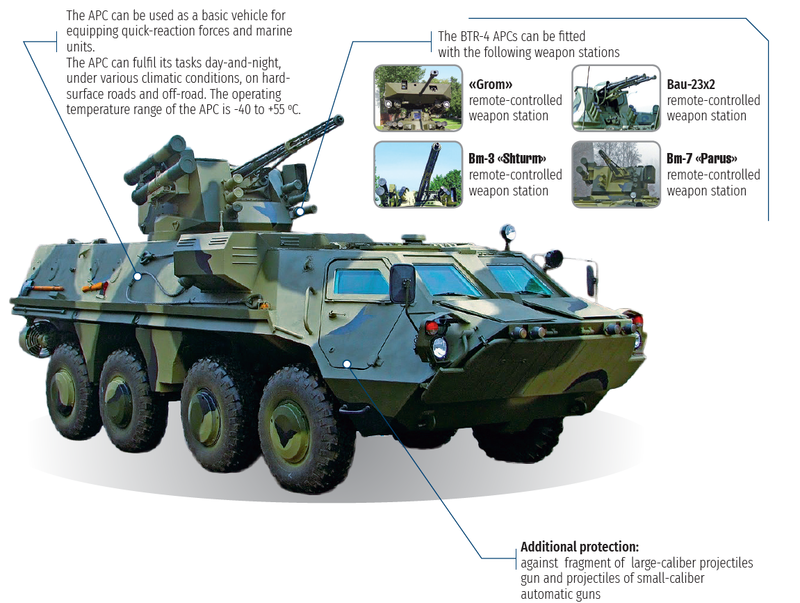
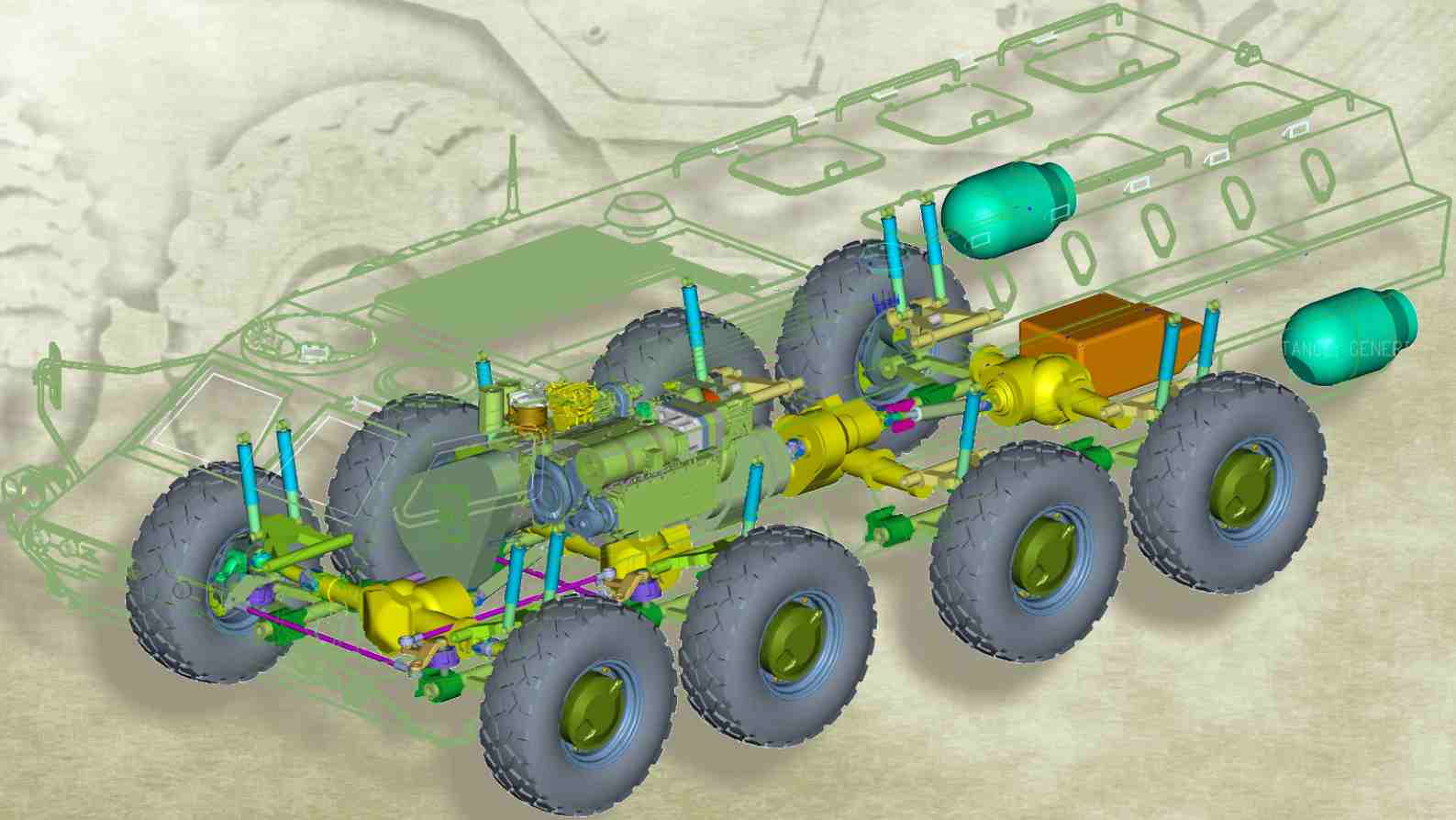
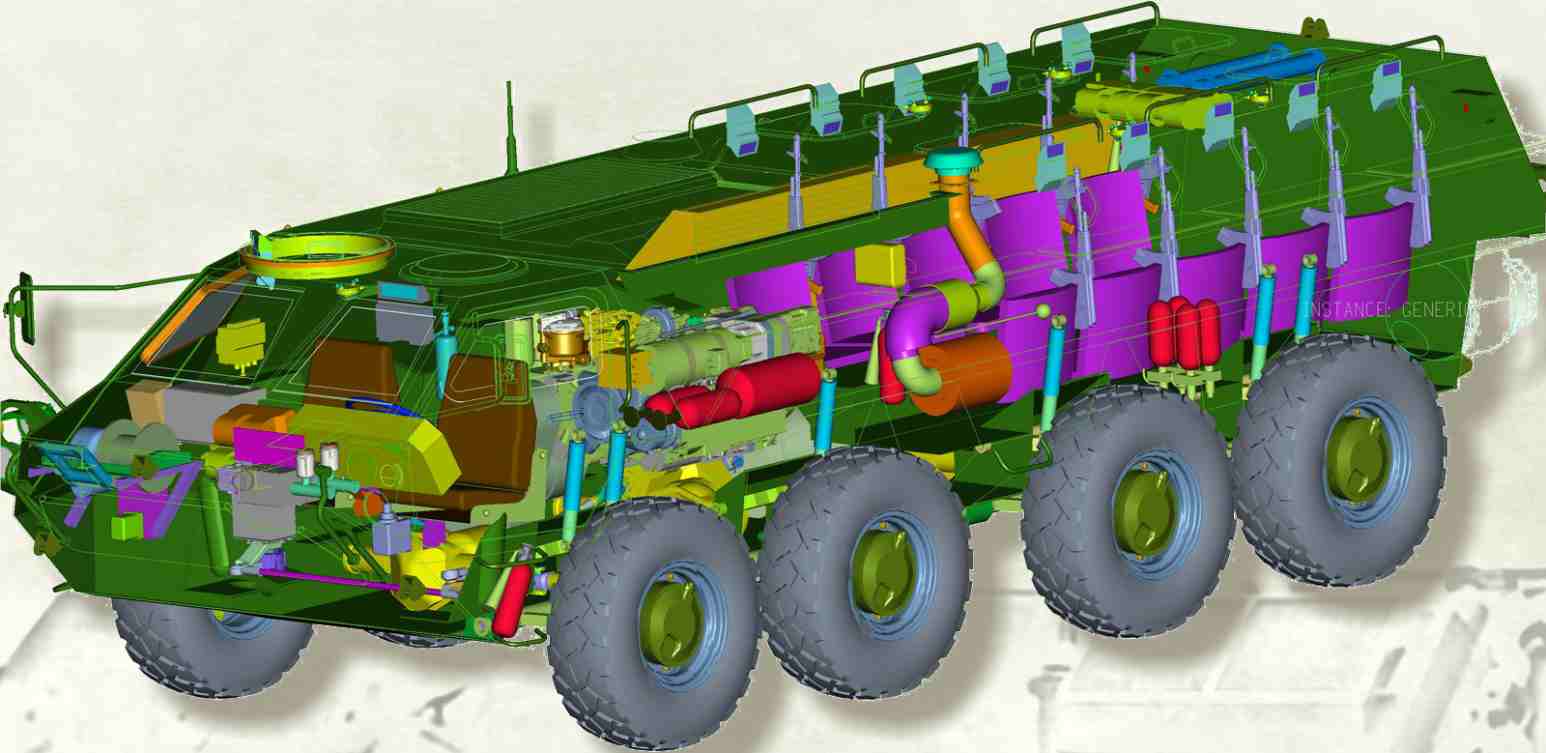

BTR-3 from the Azov Regiment in parade at Mariupol, 2021.
Superficially like the BTR-80, the BTR-3 was the result of the combination of Kharkiv Morozov Machine Building Design Bureau of Ukraine, ADCOM MANUFACTURING of Abu-Dhabi and State Scientific Technical Centre of Artillery & Rifle Arms of Ukraine for the needs of the infantry). It was understood the UAE would be its first foreign customer. Still a eight-wheel drive armored personnel carrier with edgy shapes like the previous BTR-80, the BTR-3 however was fitted with the modular KBA-105 "Shkval" unified fighting module, enabling the installation of very diverse weapons system, ranging from grenades launchers to the 90 mm Cockerill gun to answer all customer's needs.
In total the BTR-3 was produced to eight variants, and exported to Azerbaidjan, Chad, Ecuador, Kazakhstan, Myanmar (500+), Nigeria, Saudi Arabia, Sudan, Thailand (200+), UAE (90), while ukraine kept around 90 for its own armed forces. All in all, a commercial success that showed the potential of Ukraine's industry to outperform Russian's, and showed paths of improvements that can be ported onto an evolved model, that ultimately became the BTR-4.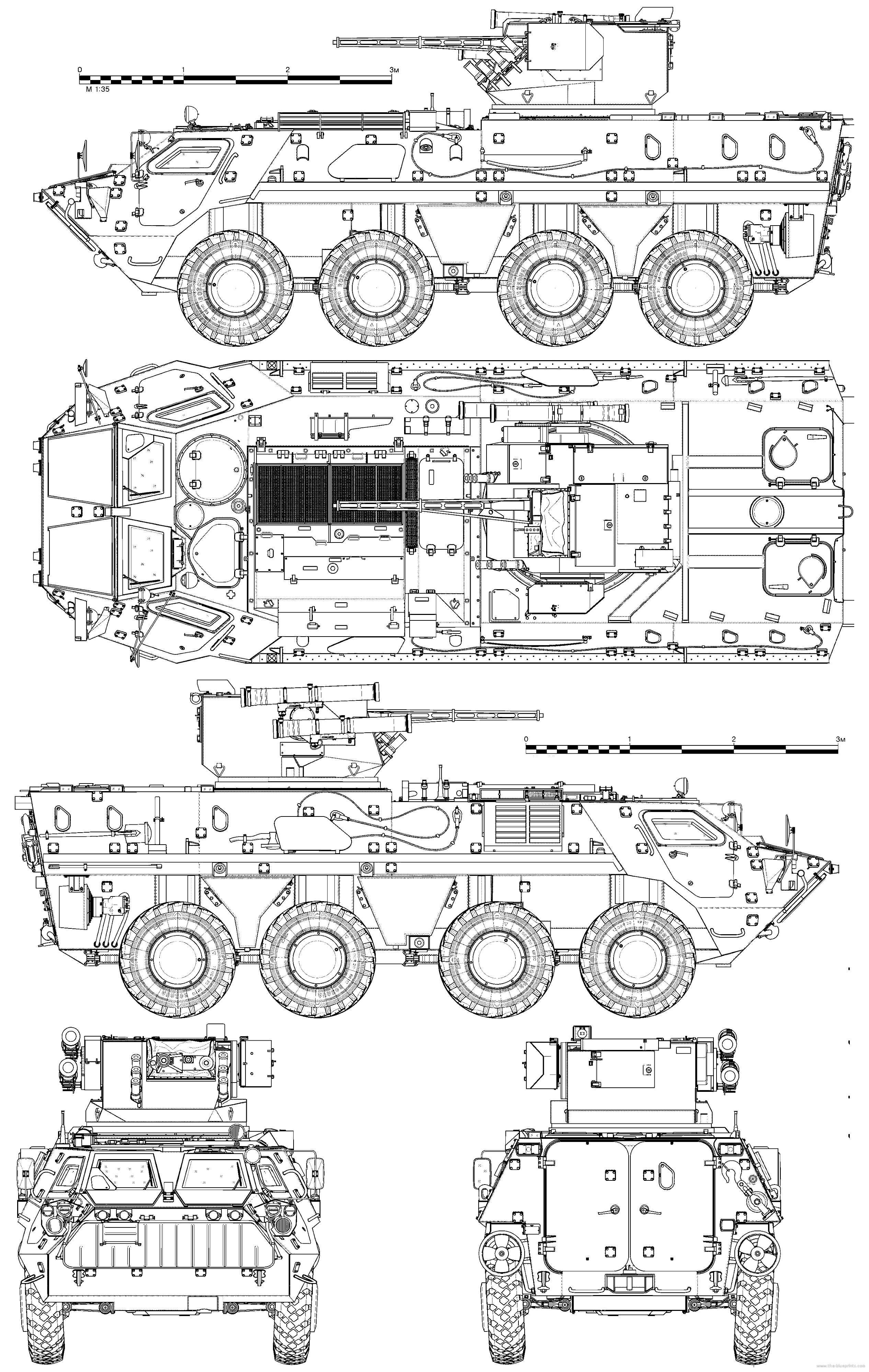
Blueprint of the type, 4 views in standard configuration.
The BTR-4 armoured personnel carrier (APC) is intended to transport personnel of mechanized infantry units and to provide fire support in combat. The APC is used for equipping military units capable of carrying out combat actions in various conditions, including NBC environment. The APC can be used as a basic vehicle for equipping quick reaction forces and marine corps. The APC can fulfil its tasks both by day and at night, in various climatic conditions, on hard surface roads and in cross-country. The operating temperature range of the APC is -40 to +55°C.
Its layout comprises three compartments, the front (driving), middle (power pack) and rear (fighting and troop) compartment. This layout makes it possible to have the whole fighting/troop compartments made for a very modular arrangement, in order to change all components along the missions, but without changing the layout of the power pack and transmission. Its carrying capacity and more powerful powerpack is intended to procure additional armour protection against automatic small-calibre guns.
The shapes were about the same as the BTR-3 but refined, with room for add-on armour and protection kits, plus the central modular weapons platform. Added weight was compensated by a much more powerful engine, more than for the BTR-3, thus making the BTR-4 a more performing vehicles. But it's production went through ups and down, and it was helped by exports. 2014 is in reality the date of the final product called the BTR-4U. But the BTR-4 was introduced much sooner, in 2008.
Indeed, after receiving many positive reiviews, the new project received a serial production approval, which started by late 2008. The first series were ten vehicles, which were evaluated thoughout 2009. It was presented in Spain as a replacement for the old Pegaso BMR also, but not chosen.
In 2012, the Iraqi Ministry of Defence, which was presented the vehicle however, ordered 420 BTR-4E IFVs, modified for their needs. This kickstarted mass production at Kharkiv and spawned more developments. However, only 88 vehicles were delivered as the Iraqi Ministry of Defense cancelled the contract, compaining about quality issues. Nevertheless, the vehicles was soon exported and declined into several variants.
-Heater for cold operations
-Night vision sight for the gunner, driver and commander
-Automatic fire suppression system
-Central tire inflation system
-9 tonnes capacity winch
-Collective NBC (nuclear, biological, and chemical) protection with full sealing and overpressure.
-White lamp and infrared lamp (left front window).
-Auxiliary Power Unit (APU) locateded in the right side box to power the Remote weapon station when the engine is shut.
-Nnavigation system SN-3003E Bazal (satellite) which antenna is close to the commander's hatch.
-Two propellers at the rear of the hull, driven for directions.
-Bilge Pumps for swimming.
The BTR-4E Bucephalus had a very modular weapon stations, and in standard came with the remotely operated weapon station (RWS) BM-3 Shturm, comprising a ZTM-1 30mm automatic cannon, coaxial KT/PKT 7.62mm light machine gun, and the AG-17 30mm automatic grenade launcher on the left side of it and two ATGM Baryer type ATGMs on the right side, making for a very exhaustive, comprehsnive set capable to answer any threat on the battlefield (The 30 mm autocannon for example is capable of engaging helicopters).
The Baryer missile uses a semi-automatic laser beam guidance system while its warhead is sufficient to defeat up to 800mm ERA equivalent. Its range is between 100 and 5,000m, with great accuracy and almost 90% first hit capability. The operating gunner is located inside the hull, seated on the right side of the troop's compartment. The commander still has full optional control of the turret, using an individual screen with the same displat and joystick. The additional weapon stations such as the BM-7 Parus, BM Grom, and BAU 23-2 are specialized as well.
Standard: Passengers: 3 crew, 8 soldiers, main armament 30 mm 2A72, coaxial 7.62 mm.
Four 9P135M Konkurs/Baryer AT missiles (1x 30 mm automatic grenade launcher, 2 AT missiles) GROM module: (3+8 crew)
30 mm autocannon, 30 mm automatic grenade launcher, 7.62 mm coaxial, four 9P135M Konkurs/Baryer
SHKVAL module: (3+8 crew), 30 mm autocannon+ 7.62 mm coax, four 9P135M Konkurs/Baryer or automatic grenade launcher option
BAU 23x2 module: (3+8 crew) 2x 23x152 mm automatic cannons, 7.62 mm coaxial
BTR-4KSh:
2x crew (driver, commander) and 5 staff (commander, four officers)
1x defensive TKB-01-1 12.7 mm machine gun
MOP-4K: 4x crew (driver, commander, gunner, loader)
120 mm cannon, 12.7 mm AA turret ringVariants
Myanmar local production
Myanmar vehicles
Nigerian BTR-4s
Iraqi vehicles
asianmilitaryreview.com Btr 4m Indonesia
On warwheels.net/
kbmia.com/
arm-nord.eu
agro-archive.ru
andrei-bt.livejournal.com
www.israeldefense.co.il
geopolitiki.com
armyrecognition.com Btr-4e_8x8
List_of_armoured_fighting_vehicles_of_Ukraine
Defense_industry_of_Ukraine
malyshevplant.com btr-4
military-today.com btr_4.htm
military-today.com/ konkurs
9M113_Konkurs
https://morozov.com.ua
army-guide.com 1
army-guide.com 2
army-guide.com 3
army-guide.com 4
army-guide.com 5
morozov.com.ua
spetstechnoexport.com
army-guide.com/
spetstechnoexport.com
army-guide.com/
wiki BTR-4
CC photos categories
On armyrecognition.com/ - description, pictures, technic
Reassessment of the Ukrainian arms industry
In 1991, when ukraine took its independence after the collapse of USSR (proclaimed on 24 August 1991, confirmed by referendum in December at overwhelming majority), the country started an assessment process to reevaluate its army on one hand, born from the leftovers of the Soviet Army as a successor state, and on the other hand, look after its industrial capabilities, which were aplenty. Ukraine was indeed producing a large number of Main Battle Tanks, IFVs and APCs in the Soviet inventory before 1990. Not ony the experience was still there, but the plants, design bureaus, cadree and skilled workers as well.In the end, all the various plants and their suppliers were grouped under the unique Ukroboronprom, as a state association of major defense conglomerates in Ukraine. The goal was to consolidate these and make a single export cell, for more efficience. Mutualized costs would allow UOP to be present in arms trade shows around the world under a single banner. Between the older T-64 and the new T-84 Oplot this military vehicle soon had a flagship, but it was decided also to modernize the soviet-era park of wheeled and tracked vehicles of the APC and IFV types.
To that end, it was seen as very profitable to modernize and resell the huge leftover of the Sovet-era fleet of vehicles, for two reasons:
1-Having a cheap, yet modernized armoured vehicle to country already possessing the originals, for limited retraining of maintenance coast and training personal 2-Propose kits to upgrade these soviet era vehicles in targeted countries, for an even lower budget.
In 2013 Ukraine's defense sector manufactured a total of 11.7 billion Ukrainian hryvnia worth of goods, ₴10 billion of which were exported and prior to 2014 a major part of the military business was based on a refreshing of these Soviet-era stockpiles. Examples were the T-64U, BMP-1U (2001), or the BTR-7, a modernization of the BTR-70/80.
However due to the limitation of said soviet-era vehicles, notably the still extant numerous BTR-60, 70 and 80, Ukraine launched itself into creating its own lineage of brand new vehicles, reusing as much as possible of the older ones, but with a modern design, producing the BTR-94 IFV, and the brand new BTR-3 and BTR-4s. The former was an evolution of the BTR-82A IFV, but the BTR-3 (2000) was its first attempt of an original vehicle alonsgide the BMPV-64 and BTRV-64 heavy IFV/APC, but also a dozen of wheeled armored vehicles.



A previous attempt: The BTR-3

BTR-3 from the Azov Regiment in parade at Mariupol, 2021.
Superficially like the BTR-80, the BTR-3 was the result of the combination of Kharkiv Morozov Machine Building Design Bureau of Ukraine, ADCOM MANUFACTURING of Abu-Dhabi and State Scientific Technical Centre of Artillery & Rifle Arms of Ukraine for the needs of the infantry). It was understood the UAE would be its first foreign customer. Still a eight-wheel drive armored personnel carrier with edgy shapes like the previous BTR-80, the BTR-3 however was fitted with the modular KBA-105 "Shkval" unified fighting module, enabling the installation of very diverse weapons system, ranging from grenades launchers to the 90 mm Cockerill gun to answer all customer's needs.
In total the BTR-3 was produced to eight variants, and exported to Azerbaidjan, Chad, Ecuador, Kazakhstan, Myanmar (500+), Nigeria, Saudi Arabia, Sudan, Thailand (200+), UAE (90), while ukraine kept around 90 for its own armed forces. All in all, a commercial success that showed the potential of Ukraine's industry to outperform Russian's, and showed paths of improvements that can be ported onto an evolved model, that ultimately became the BTR-4.
Design of the BTR-4

Blueprint of the type, 4 views in standard configuration.
The BTR-4 armoured personnel carrier (APC) is intended to transport personnel of mechanized infantry units and to provide fire support in combat. The APC is used for equipping military units capable of carrying out combat actions in various conditions, including NBC environment. The APC can be used as a basic vehicle for equipping quick reaction forces and marine corps. The APC can fulfil its tasks both by day and at night, in various climatic conditions, on hard surface roads and in cross-country. The operating temperature range of the APC is -40 to +55°C.
Its layout comprises three compartments, the front (driving), middle (power pack) and rear (fighting and troop) compartment. This layout makes it possible to have the whole fighting/troop compartments made for a very modular arrangement, in order to change all components along the missions, but without changing the layout of the power pack and transmission. Its carrying capacity and more powerful powerpack is intended to procure additional armour protection against automatic small-calibre guns.
Project development and evolution
The project came from Kharkiv Morozov design bureau in 2005 already apparently. A prototype designed as a private venture, was unveiled at the Aviasvit 2006 exhibition in Kyiv. It was an enhanced version of the BTR-3 and unlike the BTR-60/70/80, it was organized like western APCs, with the driver's and commander's compartment at the front, engine and transmission compartment in the middle, troop compartment at the rear. The troops accessed and exited the vehicle via these rear doors, enjoying a much better protection than the aforementioned vehicles.The shapes were about the same as the BTR-3 but refined, with room for add-on armour and protection kits, plus the central modular weapons platform. Added weight was compensated by a much more powerful engine, more than for the BTR-3, thus making the BTR-4 a more performing vehicles. But it's production went through ups and down, and it was helped by exports. 2014 is in reality the date of the final product called the BTR-4U. But the BTR-4 was introduced much sooner, in 2008.
Indeed, after receiving many positive reiviews, the new project received a serial production approval, which started by late 2008. The first series were ten vehicles, which were evaluated thoughout 2009. It was presented in Spain as a replacement for the old Pegaso BMR also, but not chosen.
In 2012, the Iraqi Ministry of Defence, which was presented the vehicle however, ordered 420 BTR-4E IFVs, modified for their needs. This kickstarted mass production at Kharkiv and spawned more developments. However, only 88 vehicles were delivered as the Iraqi Ministry of Defense cancelled the contract, compaining about quality issues. Nevertheless, the vehicles was soon exported and declined into several variants.
Precise Design specifics
The BTR-4 is overall more flexible than the BTR-60/70/80s, having much more modular layout to adapt it for various missions with ease. The goal was to be armed according to customer requirements. Protection is improved all across the board, more modular also, and to answer the added weight, and upgrades, an engine twice as powerful of the older ones is used. The seven infantrymen at the rear enter and leave via a rear double door opening outwards. The right one has a single firing port. Soldier ahd indivdually seated, facing inwards, with four either each side. Howeber the side hull is dotted by three firing ports eac side, and three to four day vision blocks on the roof.Hull
The driver is located to the front cabin accseeing through prismatic front-opening side doors, with the commander to his right. Both can see through a bulletproof window, which is hinged at the top on its upper part, covered in combat by an armored plate, but they also has individual round, single-piece front-opening hatches on the roof.Protection
In addition to the front cab bulletproof windows and armoured shutters, the hull is proof against small arms fore (7.62mm AP NATO standard) as shell splinters, Level 2 STANAG 4569. The vehicle is not proof against IEDs and mines but sill possesses an anti-mine skirt. There is an optional add-on armor kit to be attached to the side panels and provide protection against 30mm caliber shells. Slat armor can be fitted for maximum protection against RPG attacks (rocket-propelled grenades) and HEAT warhead equipped weapons. The standard is a Grom module with attachment for a BAR cage mast only. For active protection, the BTR-4 mounts on either side of the armament module a bank of three electrically operated smoke grenade launchers, so six in all.Powerplant
The vehicle is powered by a 3TD diesel engine and in the BTR-4E, a Deutz EBPO III rated for 500 hp-600 hp which is coupled to a 5 forward, 1 reverse gearbox. The 8x8 chassis is a bit larger than for the BTR-80 and work with independent suspension but also automatic transmission and uses hydro-mechanical transmission with pass-through axles.Performances
The BTR-4 has a maximum speed of 110 km/h. It can cross water obstacles at a speed of 10 km/h. It's power-to-weight ratio with anti-bullet protection is at least 28.6hp/ton and with additional protection 20 hp/ton. It's Cruising range is beyond 690 km, and the vehicle was tested and proved capable of climbing a 60° gradient, and stay stable on a 40° side slope, 0.6 m vertical obstacle and gap a 2m trench. The vehicle has a good tactical mobility, it can be airlifted by any heavy dury trabsport model of Soviet or NATO standard (four engines type), and is fully amphibious, able to perform sea operations at Sea State 3 in 1.25m waves. Erection of the folded nose trim vane and activation of the air intake expansion pipe on the left side fitted on the engine outlet also ensured no flooding when swimming, added to the bilge pumps.Equipments
Independent of the armament modules, the vehicle possesses:-Heater for cold operations
-Night vision sight for the gunner, driver and commander
-Automatic fire suppression system
-Central tire inflation system
-9 tonnes capacity winch
-Collective NBC (nuclear, biological, and chemical) protection with full sealing and overpressure.
-White lamp and infrared lamp (left front window).
-Auxiliary Power Unit (APU) locateded in the right side box to power the Remote weapon station when the engine is shut.
-Nnavigation system SN-3003E Bazal (satellite) which antenna is close to the commander's hatch.
-Two propellers at the rear of the hull, driven for directions.
-Bilge Pumps for swimming.
Armament
The prototype is armed with the locally designed New Armament Module, centered around a 30mm 2A72 automatic cannon and 7.62mm coaxial machine-gun, and backed for long range by four 9P135M Konkurs or Baryer anti-tank missiles (two on each side of the turret). It is alternative to a 30mm automatic grenade launcher in place of the AT missiles on one left. Various turret weapons modules were prpoposed like the GROM, SHKVAL and BAU 23x2 modules.The BTR-4E Bucephalus had a very modular weapon stations, and in standard came with the remotely operated weapon station (RWS) BM-3 Shturm, comprising a ZTM-1 30mm automatic cannon, coaxial KT/PKT 7.62mm light machine gun, and the AG-17 30mm automatic grenade launcher on the left side of it and two ATGM Baryer type ATGMs on the right side, making for a very exhaustive, comprehsnive set capable to answer any threat on the battlefield (The 30 mm autocannon for example is capable of engaging helicopters).
The Baryer missile uses a semi-automatic laser beam guidance system while its warhead is sufficient to defeat up to 800mm ERA equivalent. Its range is between 100 and 5,000m, with great accuracy and almost 90% first hit capability. The operating gunner is located inside the hull, seated on the right side of the troop's compartment. The commander still has full optional control of the turret, using an individual screen with the same displat and joystick. The additional weapon stations such as the BM-7 Parus, BM Grom, and BAU 23-2 are specialized as well.
Standard: Passengers: 3 crew, 8 soldiers, main armament 30 mm 2A72, coaxial 7.62 mm.
Four 9P135M Konkurs/Baryer AT missiles (1x 30 mm automatic grenade launcher, 2 AT missiles) GROM module: (3+8 crew)
30 mm autocannon, 30 mm automatic grenade launcher, 7.62 mm coaxial, four 9P135M Konkurs/Baryer
SHKVAL module: (3+8 crew), 30 mm autocannon+ 7.62 mm coax, four 9P135M Konkurs/Baryer or automatic grenade launcher option
BAU 23x2 module: (3+8 crew) 2x 23x152 mm automatic cannons, 7.62 mm coaxial
BTR-4KSh:
2x crew (driver, commander) and 5 staff (commander, four officers)
1x defensive TKB-01-1 12.7 mm machine gun
MOP-4K: 4x crew (driver, commander, gunner, loader)
120 mm cannon, 12.7 mm AA turret ring
Variants
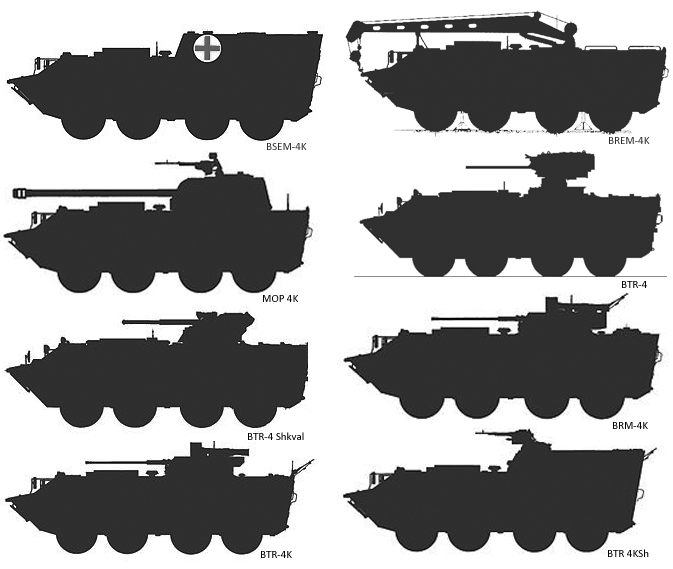
BRM-4K
Reconnaissance vehicle.
BTR-4K
Command vehicle.
BTR-4KSh
The Command vehicle variant of the BTR-4 family. Sharing the same rear enlarge compartment with the medical BSEM-4K, this vehicle saw a limited production overall. If the BTR-4K is hardly different from the regular BTR-4 apart extra communication sets, KSh is an upper echelon unit Staff and command vehicle. It had a combat weight of 18t, and a 7-man crew. The rear compartment is raised in order to accomodate more personal in better conditions in addition of extra communication sets.
BTR-4E1
Basic export version with the BM-3 Shturm (ZTM-1 30mm automatic cannon).
BTR-4MV1
Same vehicle, upgraded to NATO standard with increased protection.
MOP-4K
Fire support vehicle, with the 2S34 Chosta gun on a modified turret. It seems it stayed at prototype stage only, no photo.
BREM-4K
Repair and recovery vehicle: It has a crane with a 3t lifting capacity, a winch with a 6.8t pulling capacity, welding equipments working at 350A, and towing devices.
BSEM-4K
Recovery and medical vehicle, this is a modular utility vehicle which aft raised compartment could be used both for
BMM-4A
Apparently similar in role to the BMM-1 of the BTR-80 family as first-aid and battlefield evacuation vehicle.
BMM-4B
Same as the BMM-2, battalion level initial medical treatment vehicle
BMM-4C
Similar to the BMM-3, mobile field hospital
BSEM-4K
This ambutank shares the same rear raised compartment to take on four stretchers or more (medical evacuation), more to come.
BMM-4 Series
The BMM 4 started as a simple conversion of the BTR-80 based BMM-1 medical evacuation vehicle, with the same suite asd the model A. The model B was developed as a Batallion level evacuation vehicle with the same raised roof aft, tall enough for standing personal and up to four stretchers. But the true best seller was the BMM-4C, derived from the BTR-3C as a more advanced battlefield medical treatment, and not just evacuation vehicle.
BTR-4MV1 (2021)
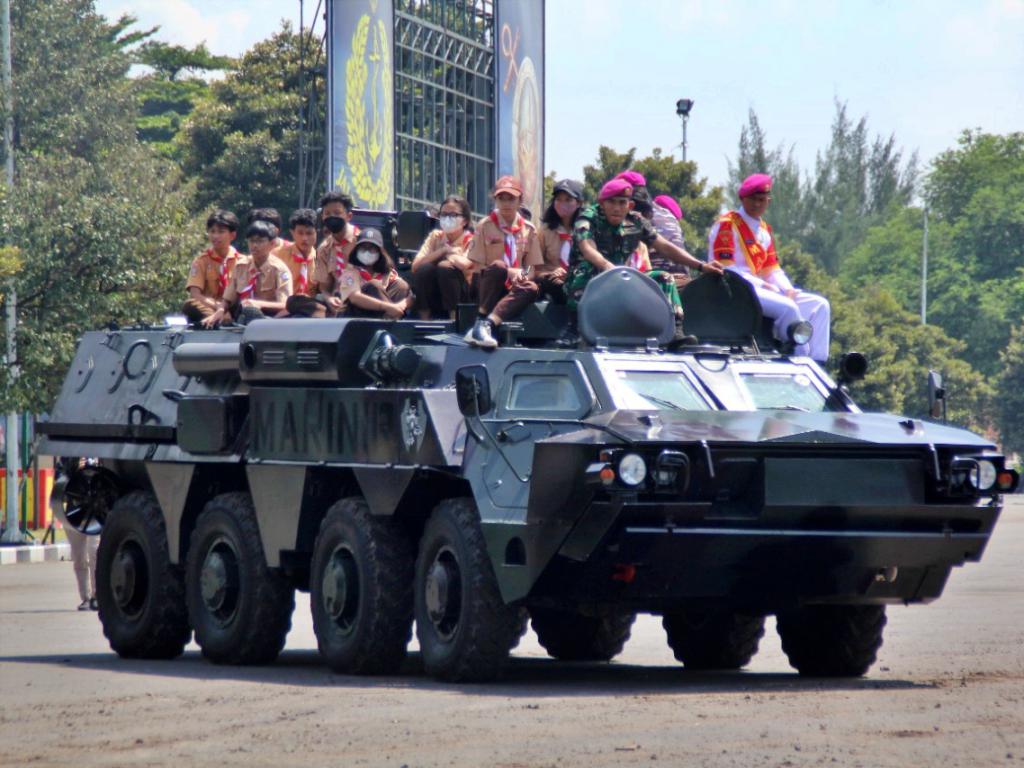
Indonesian Marines BTR-4M, note the very different nose.
The Ukrainian state defense manufacturer (UkrOboronProm) unveiled a prototype BTR-4MV1 derived from the BTR-4, and designed in accordance with NATO standards. It's modified configuration is the the vehicle's hull, now flat and allpwing to added additional types of protection, ceramic plates and ERA bricks, to reach the 4th and 5th STANAG protection levels in accordance with NATO standards. The hull rear is fitted with a single eletric ramp, and modified rear compartment wit greater room to accomodated larger-size cargoes or modules. The initial version BTR-4M has been sold to Indonesia, caracterized by a modified nose, but the BTR-4MV1 marketed to Thailand is a completely different animal.
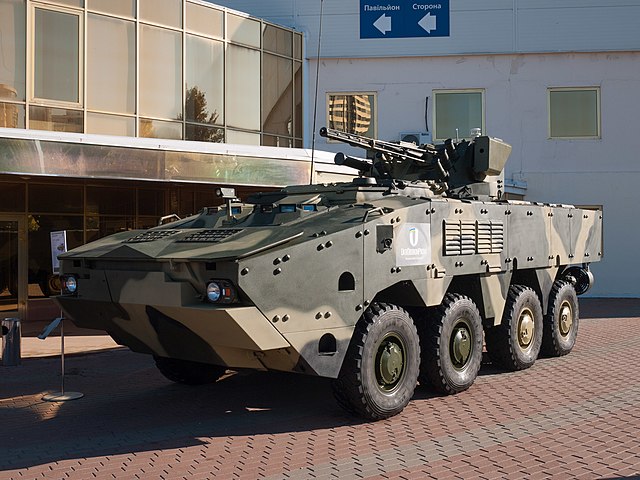
BTR-4MV1 in Kiev, 2018, demonstrated to Thailand. Brand new hull. Will be trated as a standalone in the future.
Exports
So far the BTR-4 has been sold to the following:
- Indonesian Marine Corps: 5 BTR-4M (2x BM-7 Parus) 2017. 55 cancelled. 21 BT-3F, 22 BMP-3F vehicles instead 2019.
- Iraq: First customer, 220 ordered (40 rejected), 88 delivered 2013, 270 total.
- Nigeria: 5 delivered in 2014, Nigerian Police
- Ukraine: 10 in 2009, 170 vehicles by 2018, 200 in January 2021. 10 to the Ministry of Internal Affairs 2014 (National Guard) and 40 to NGU 2014.
- Myanmar: Plant built for manufacturing the BTR-4E 2019, ongoing.
- Russia: 20+ allegedly captured by Russian forces in 2022.
And potential buyers...
- North Macedonia (FYROM): evaluation process for 200 vehicles
- Thailand (Marines): Interest for the BTR-4MV1, October 2018.
Some Ukrainian BTR-4s used in 2022 came from rejected Iraqi batch, or circa 40 vehicles. It seems quality control is poor in Ukraine, between degraded engine performances or outright rust/damage to freshly delivered vehicles. Refusal of a delivered material is rare and led to large cancellations for both Iraq and Indonesia, for a potential 400 vehicles loss for the company.

Iraqi BMM-4A (Ambutank). I was featured together with TR-4Es in an Operation to recapture Jurf Al Sakhar from ISIL forces on 24 October 2014, which was a success.

Nigerian BTR-4 src also tailored version (twitter)
The BTR-4 in action
The Ukrainian army took over the remaining ex-Iraqi 52 BTR-4E, and from April 2014, the National Guard also started to received their first BTR-4E. By May-June 2014 the vehicles were already involved in the siege of Sloviansk, liberated on 5 July 2014 from the separatists and Russians, as the front moved back to the Donetsk. Soldiers praised the BTR-4E for its more advanced armour, better mobility, and quality optics. They took heavy machine gun fire, snrapnel and RPGs, but performed well through the use of slat-armor and Kevlar. On October 4, 2014, separatists captured a command version BTR-4K, which slat-armor new paint were particular. The vehicle was later shown in use by the elite Vostok Battalion (Russian GRU officers).
It was announced by June 2014 that the BTR-4E was in action in the Sloviansk area, hit by large-caliber machine guns and RPGs, but their BAR armor protected the crew, armored glass resisting to direct hits from AP sniper rifles bullets. They kept their original desert camo and they saw action as well in the 2022 Russian invasion of Ukraine. So far, according to Spioenkop it seems that 77 BTR-4 has been lost in combat, including likely the 40 ex-Iraqi vehicles scr.
BTR-4E specs | |
| Dimensions | 7.76 x 2.93 x 3.02m (25.5 x 9.6 x 9.9 ft) |
| Total weight, battle ready | 17.5+3 t or 25+3 t with addon armour |
| Crew | 3+8, see notes |
| Propulsion | 3TD diesel engine or DEUTZ EURO III, 489-598 hp |
| Suspension | wheeled 8×8, torsion bars, hydraulic dampeners |
| Speed | 110 km/h (68 mph) or 10 km/h (6.2 mph) swimming |
| Range | 690 km (430 mi) |
| Armament | 2A72 30 mm (1.2 in) autocannon, 7.62 mm coaxial LMG, 2-4 ATGMs, see notes |
| Armor | Welded steel, small arms fire or 30 mm rds with addon-armour |
| Production | Circa 600, ongoing |
Sources/Links
Myanmar local production
Myanmar vehicles
Nigerian BTR-4s
Iraqi vehicles
asianmilitaryreview.com Btr 4m Indonesia
On warwheels.net/
kbmia.com/
arm-nord.eu
agro-archive.ru
andrei-bt.livejournal.com
www.israeldefense.co.il
geopolitiki.com
armyrecognition.com Btr-4e_8x8
List_of_armoured_fighting_vehicles_of_Ukraine
Defense_industry_of_Ukraine
malyshevplant.com btr-4
military-today.com btr_4.htm
military-today.com/ konkurs
9M113_Konkurs
https://morozov.com.ua
army-guide.com 1
army-guide.com 2
army-guide.com 3
army-guide.com 4
army-guide.com 5
morozov.com.ua
spetstechnoexport.com
army-guide.com/
spetstechnoexport.com
army-guide.com/
wiki BTR-4
CC photos categories
On armyrecognition.com/ - description, pictures, technic
Gallery
Illustrations
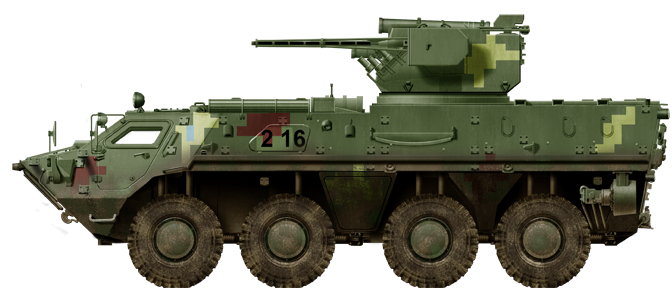
Standard Ukrainian BTR-4
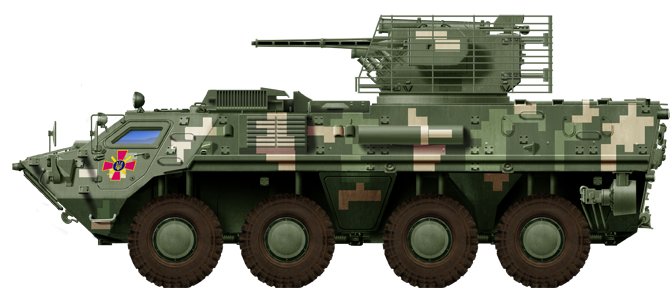
BTR-4 of the mixed KsH hull and BAR armored RWS
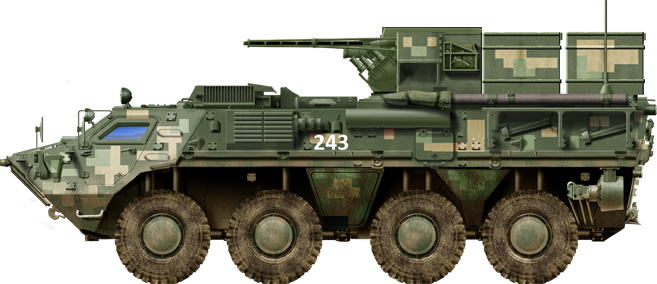
BTR-4K Command/EW vehicle
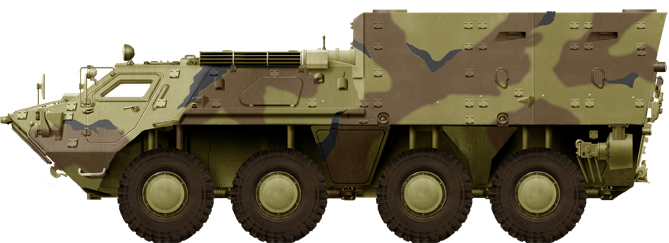
BTR-4KSh Command/staff vehicle (new)
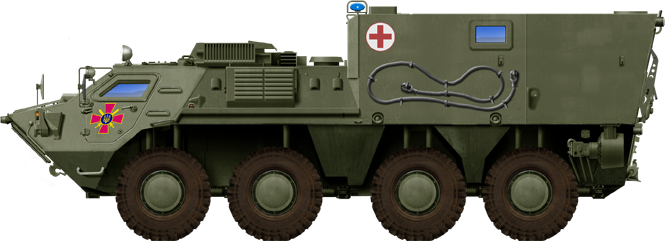
BMM-4C
(To come, BREM 4K)
Photos
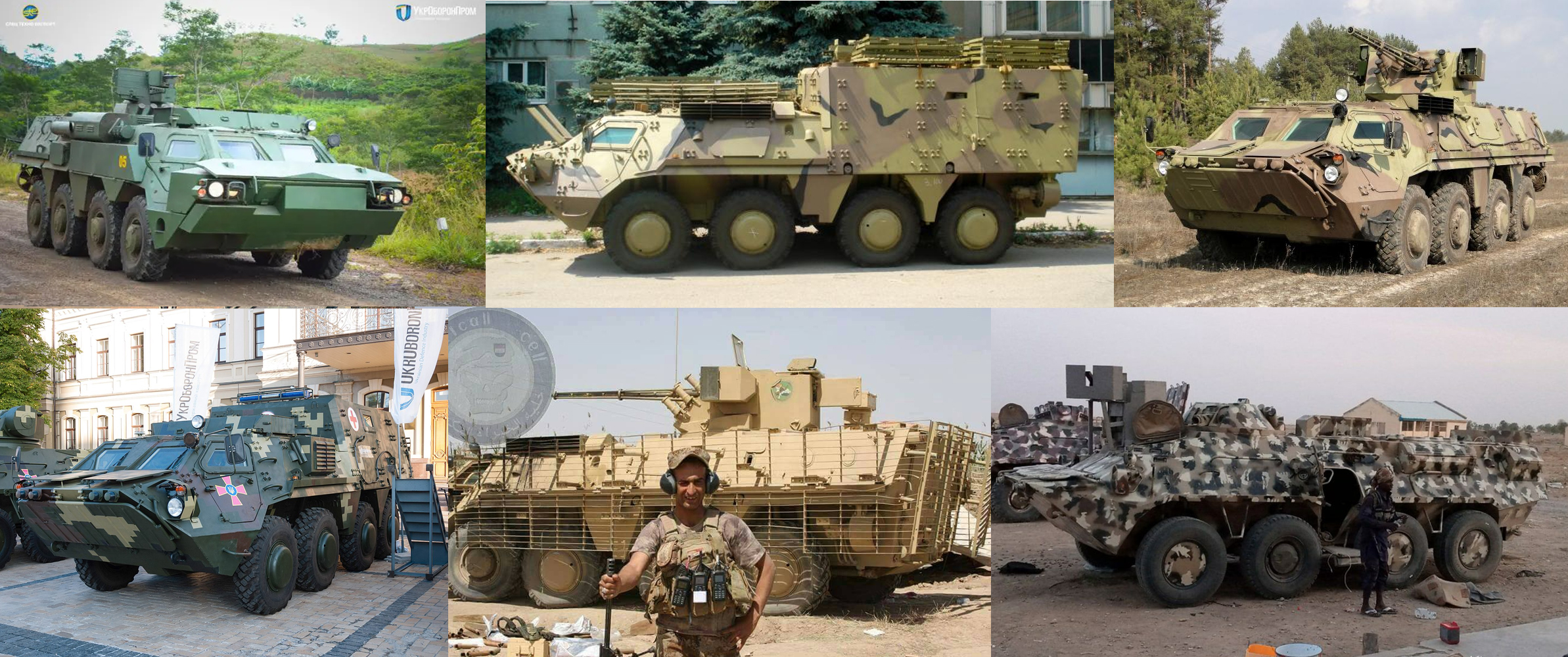
Various references from across the web.
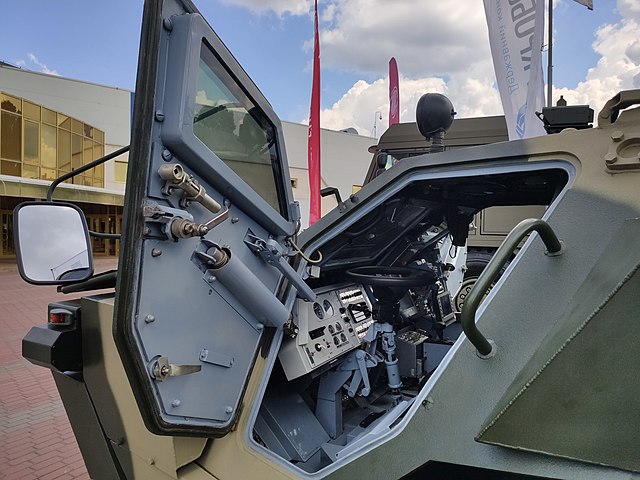
BTR-4 APC cab open doors
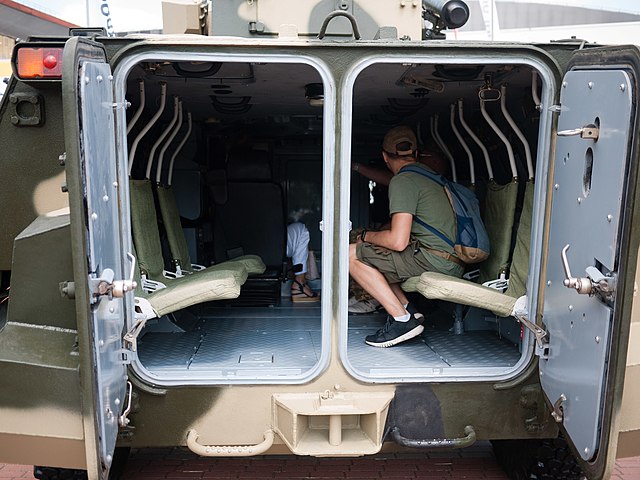
Same, troop compartment view
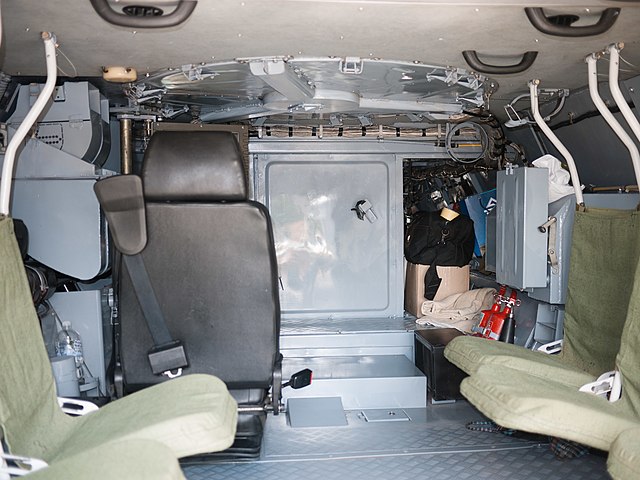
same, further inside, with the upper RWS base at the roof and left gunner's seat.
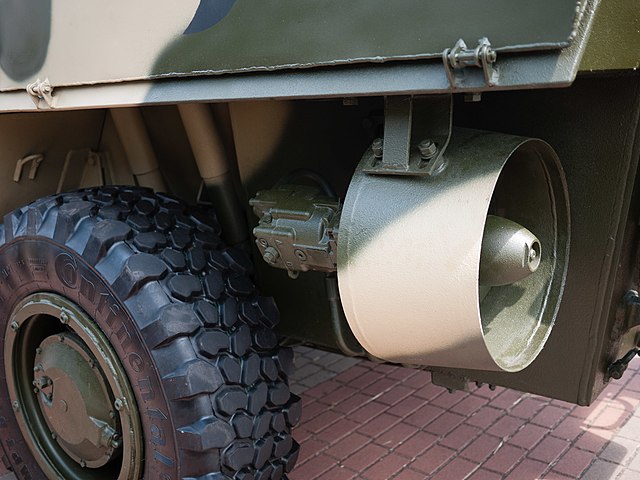
Rear propellers
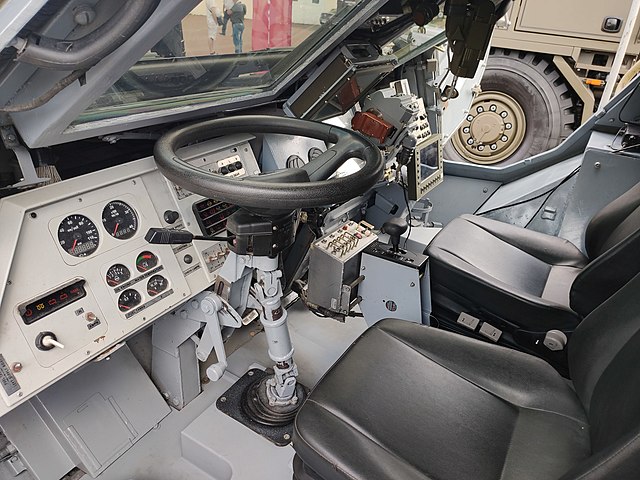
BTR-4 interior cab view, dashboard and commands
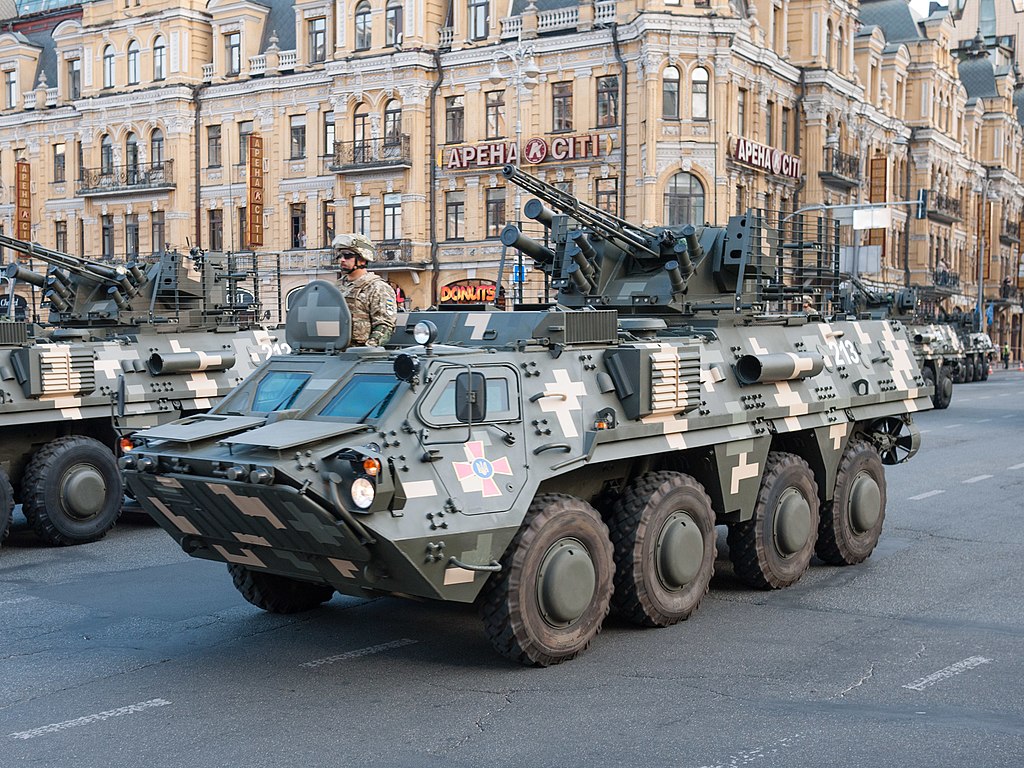
BTR-4E with BAR turret armor, Kiev 2021
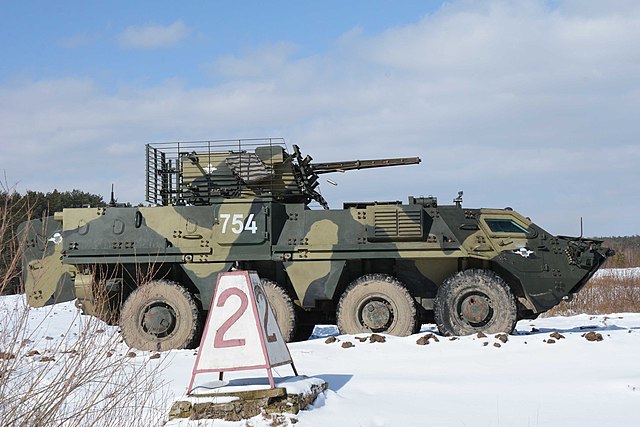
Another BTR-4 with Turret BAR protection
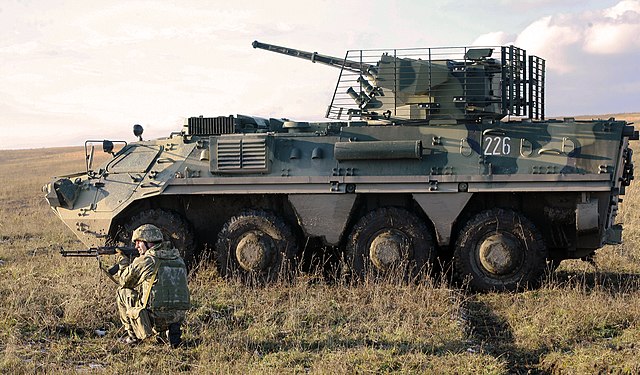
Same
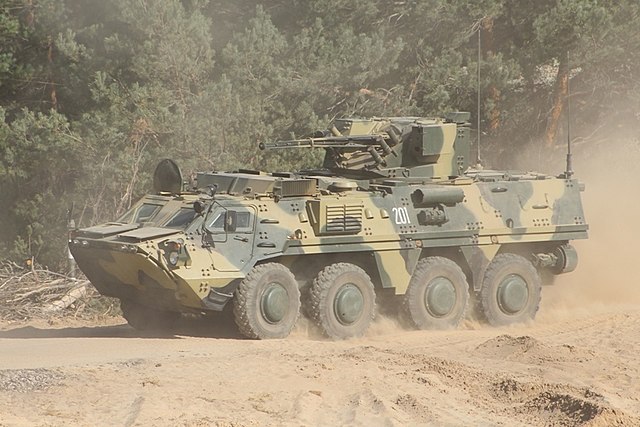
Another vehicle being trialled
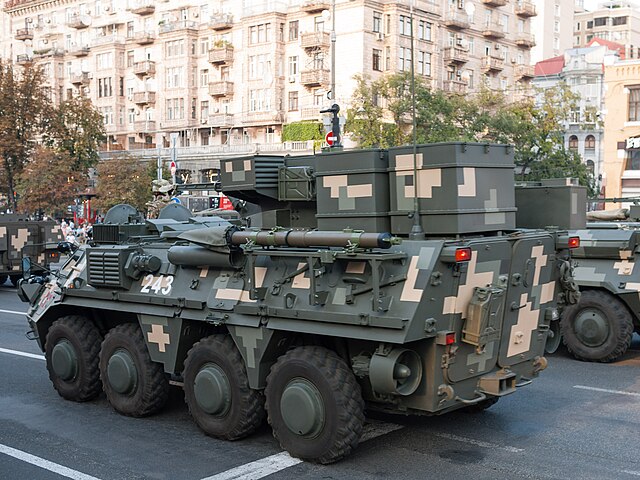
BTR-4KsH in Kiev 2021
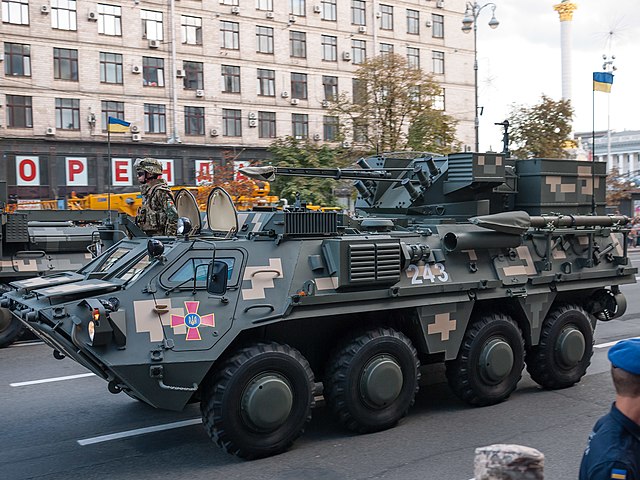
Same, front view.
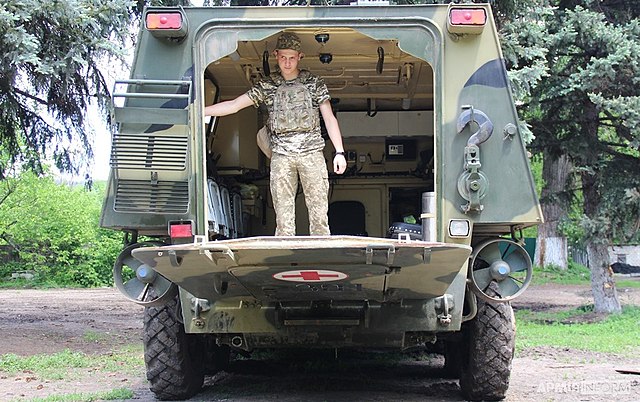
BMM4S ambulance version in 2021
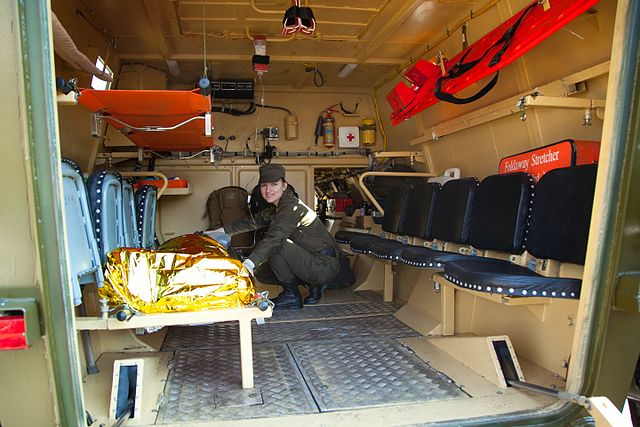
BMM4S interior being converted, with stretchers instead of seats (left)
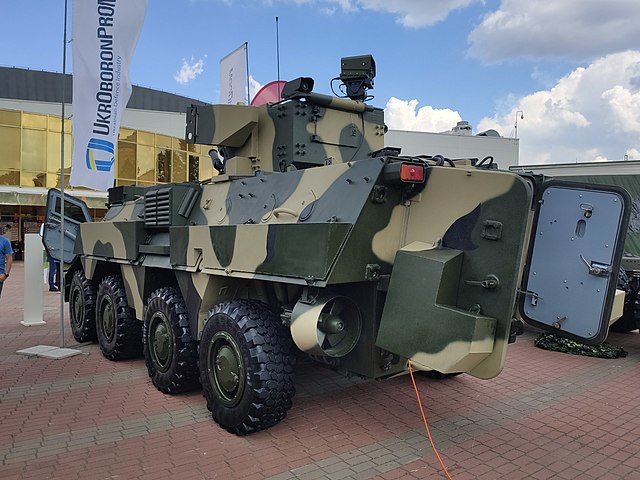
APC rear in Kiev 2021
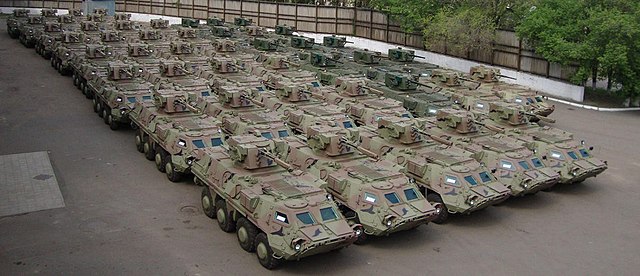
Iraqi BTR-4
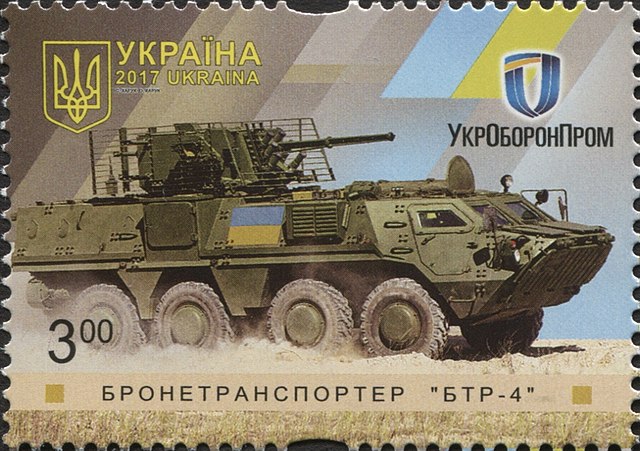
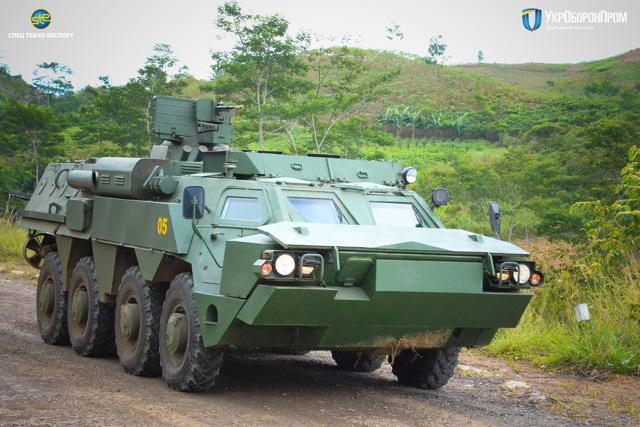
BTR-4M
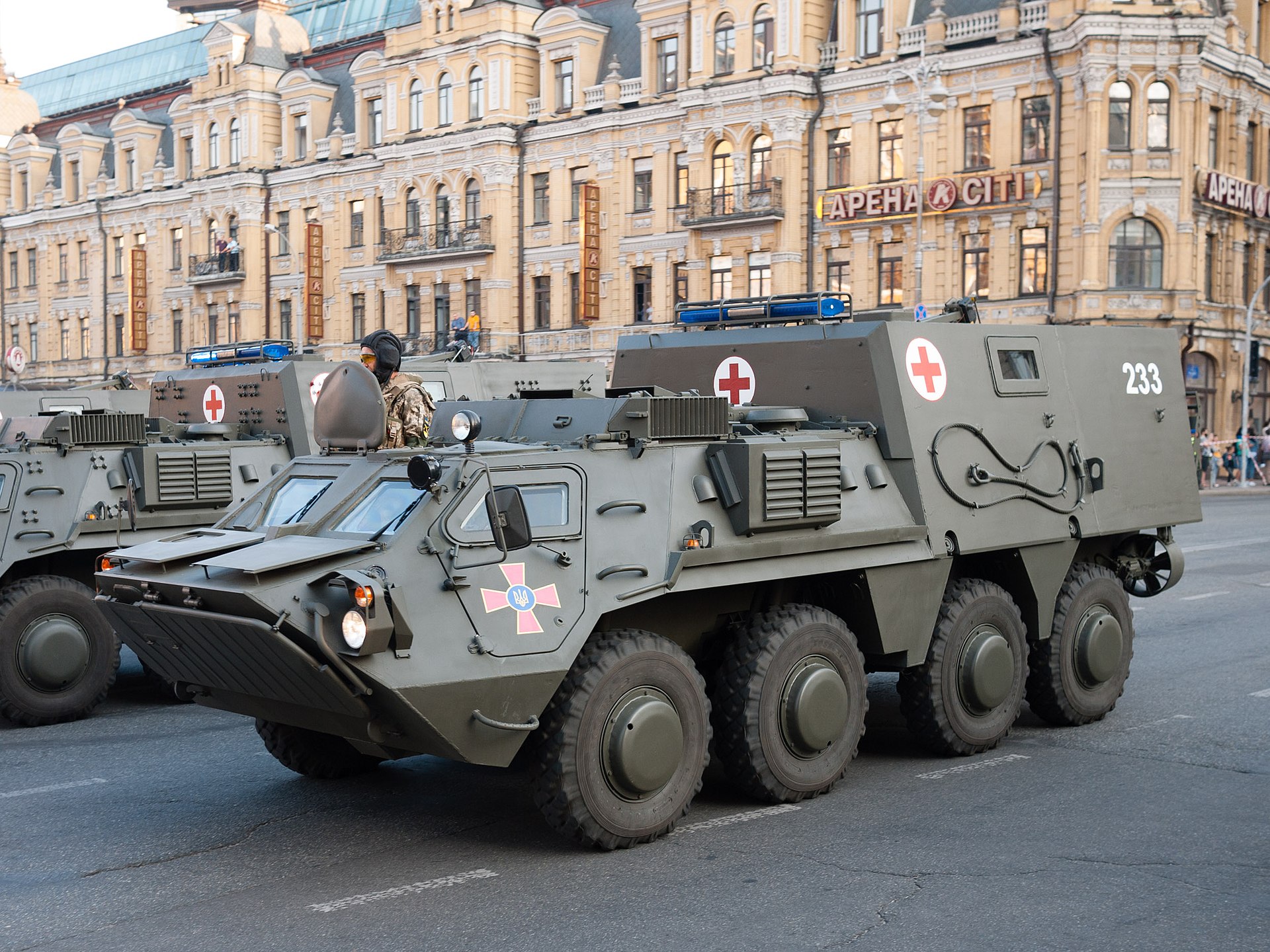
BMM-4s ambulance
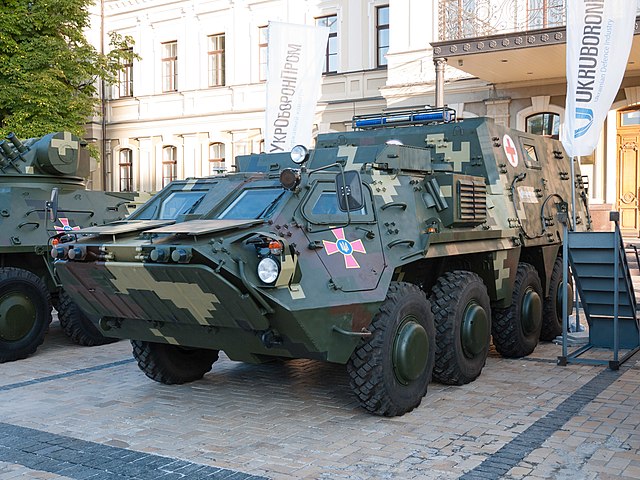
Same, Kiev
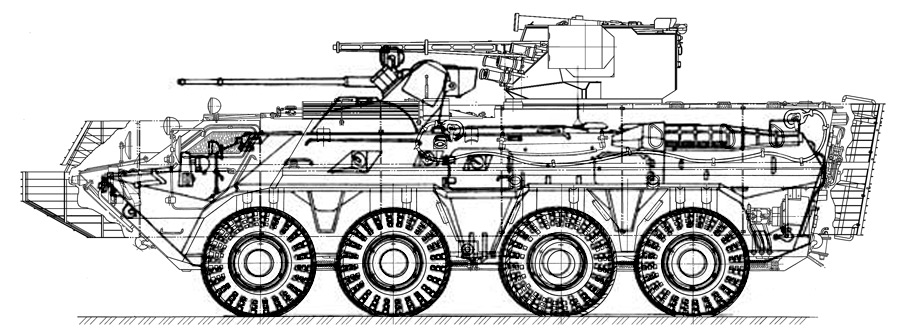
BAR armor scheme
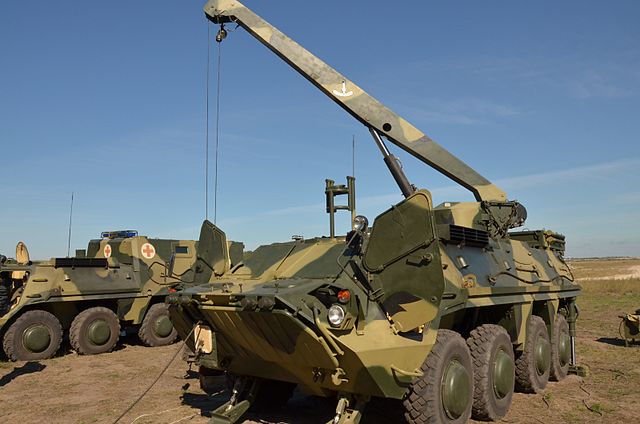
BREM-4K
Video

Modern Tanks
Modern MBTs posters

Denel Bagder (2018)

Type 16 MCV (2016)

Gepard 1A2 last rounds 2011

SANDF

Russian AFVs

Main Battle Tanks
